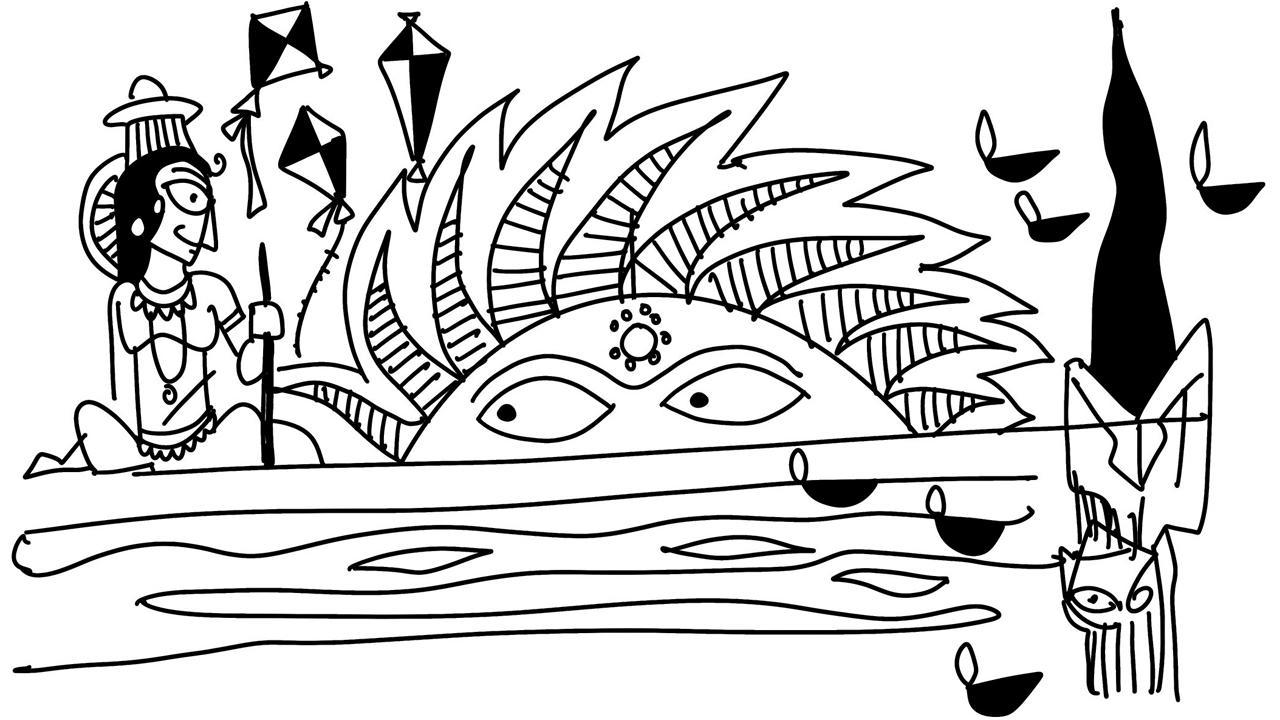Both the Deccan festival of Ugadi and the Malayali festival of Vishnu happen around the spring equinox, marking the start of the monsoon winds that took traders across the sea, from Arabia through India to Southeast Asia

Illustration/Devdutt Pattanaik
 In most cultures, festivals follow the seasonal cycle, the exception to this rule is Islamic festivities. This is because the Islamic Hijri calendar is based on the moon and is 10 days short of the standard solar year of 365 days, and so, events are not mapped with the cycle of seasons. As a result, we find Ramadan appearing in different seasons in different years.
In most cultures, festivals follow the seasonal cycle, the exception to this rule is Islamic festivities. This is because the Islamic Hijri calendar is based on the moon and is 10 days short of the standard solar year of 365 days, and so, events are not mapped with the cycle of seasons. As a result, we find Ramadan appearing in different seasons in different years.
In Christianity, we notice a clear seasonal pattern of festivals. In March each year, there is both the Day of Annunciation, when Jesus Christ was conceived in the Virgin Mary, as well as the Easter Sunday celebration, when Jesus resurrects himself after three days following his crucifixion on Good Friday. Precisely nine months later, in the height of winter on December 25, Christmas is celebrated as the day of Jesus’s birth. Thus, we see conception and rebirth linked to spring and birth linked to the winter months.
In India, the year is divided into two halves based on the location of the rising sun. When the Sun moves in the northern direction from Jan to June, it is the bright half of the gods. When the Sun moves in the southern direction from June to December, it is the dark half of our ancestors. The bright half involves celebrations where white sesame is consumed, as during Makar Sankranti, when the Sun enters the constellation of Capricorn. By contrast, black sesame is used in the dark half of the year, during “shraadh” week, and Diwali celebrations.
Both the Deccan festival of Ugadi and the Malayali festival of Vishnu happen around the spring equinox, marking the start of the monsoon winds that took traders across the sea, from Arabia through India to Southeast Asia.
The Vedas also divided the year into three parts: pre-monsoon, monsoon and post-monsoon. Pre-monsoon, we find fires being lit as during Lohri. Following this comes the spring festival of Basant Panchami when the fields are covered with yellow mustard flowers, this festival is linked to the god of love, Kamadeva, who is linked to the Sun god, who brings warmth to the earth and inspires poets and musicians and artists. This was the festival of courtesans, singers, dancers and entertainers, at one time.
Precisely forty days later, there is Maha-Shivaratri, on the eve of the New Moon. It marks the marriage of Shiva and Shakti. The day before, fires are lit to remind us of the burning of Kamadeva by Shiva before he agrees to marry Parvati. Fifteen days after Shivaratri comes the Holi festival when Kama is resurrected completely and summer arrives. People bathe in cold water and colour is thrown in every direction. Kama is reborn. Just like Christ.
Then comes the rains, when movement is restricted. As the rain wanes, demons like Mahisasura and Ravan are killed during Dussehra while Naraksura is killed during Diwali, marking the harvest. This is when the Goddess is all powerful. When she is Durga and Kali, protecting the world while the gods sleep. In autumn, she dances as Radha with Krishna. When Vishnu wakes up, she becomes Lakshmi, and marries him in the form of the basil plant.
The author writes and lectures on the relevance of mythology in modern times. Reach him at devdutt.pattanaik@mid-day.com
 Subscribe today by clicking the link and stay updated with the latest news!" Click here!
Subscribe today by clicking the link and stay updated with the latest news!" Click here!










